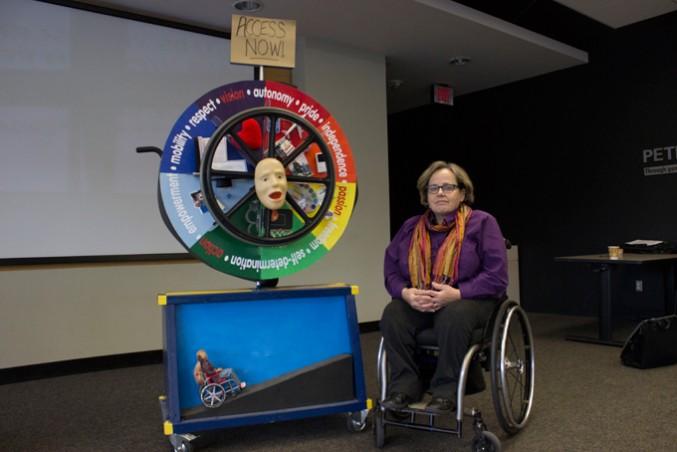By Emily Craig-Evans
Ryerson’s accessibility coordinator Heather Willis presented her art piece “Reinventing the Wheel” on Dec. 2 in recognition of International Day of Persons With Disabilities. International Day of Persons with Disabilities was on Dec. 3.
The event was the final in a series of “ImpactU” workshops hosted by the Office of Equity Diversity and Inclusion, which each had the goal of encouraging people to engage in conversations they do not normally engage in.
“Reinventing the Wheel” is a multimedia sculpture that Willis created for her capstone project when she was in her final year as a Ryerson student in the School of Disabilities program in 2005. It is an approximately five foot piece with her old wheelchair wheels mounted on juxtaposing sides. Inside eight sections divided by the spokes of the wheels are objects or images meant to raise questions about the different ways the wheel chair is negatively perceived by society on one side and positively by wheelchair users on the other.
Willis based her piece on the findings of sociologists Nick Watson and Brian Woods in their paper “No Wheelchairs Beyond This Point: A Historical Examination of Wheelchair Access in the Twentieth Century in Britain and America.”
“It explores the tragedy verses freedom that the wheelchair represents,” Willis said.
Willis hopes her piece will get people thinking about the social model of disability which she and disability activists firmly stand behind. The social model of disability avoids pathologizing disability and aims to relocate the origin of barriers from human beings to the environment.
“It’s not the impairment itself that creates disability. Disability is created by systemic and attitudinal barriers,” Willis said.
Bordering the side of the sculpture means to reflect the ways society interprets the wheelchair with negative words including, “confined,” “defective,” “pity,” and “fear.”
Inside one section between the spokes are images of popcorn, Tiny Tim and Captain Hook, which causes viewers to consider the helpless or scary tropes of disability in pop culture and film.
Contrasting this was a section with Superman. Willis talked about a time when she was taught how to jump curbs in her wheelchair and pointed out how excessively congratulating people with disabilities for overcoming barriers can be problematic.
“The more we applaud people for overcoming barriers the less obligation there is to remove barriers,” Willis said.
Another section with vegetables was created with Terry Shiavo and media portrayal of disability in mind. Shiavo was fully paralyzed following resuscitation after a heart attack and could not speak although appeared alert. Shiavo was repeatedly described in media as being in a vegetative state and died in 2005 as a result of the successful conclusion of her husband’s long legal battle to have her feeding tube removed.
The final section Willis discussed contained a stethoscope and a pill bottle, representative of the medical model of disability which perpetuates the negative associations with disability bordering the wheel. The medical model of disability views persons with disabilities as intrinsically at a disadvantage and in need of curing.
The opposite side of the sculpture depicts what the wheelchair and disability means to the disabled community, and suggests that accessibility needs to be integrated into society, not that disability needs to be cured.
Bordering the wheel on this side are positive words, including “autonomy,” “empowerment,” “respect,” and “pride.”
The eight sections on this side include motifs representative of how the wheelchair can allow persons with disabilities access to relationships, education, arts, employment and sports that they would not otherwise be able to. Perhaps the most powerful is the section with open handcuffs, symbolizing the freedom the wheelchair can provide a person with a mobility disability.
Willis repeated that it’s not just the wheelchair that represents this freedom. A cane, hearing aid, screen reader or medication could represent the same freedom to persons with different disabilities.
What’s important, Willis said, is that people are mindful of the fact that accessibility looks different for everyone.
The centre of the positive side of her sculpture contains a mask with a popular social activism phrase written inside the mouth.
“Nothing about us without us.”










Leave a Reply